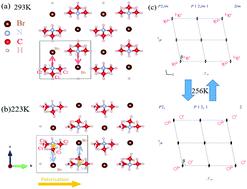当前位置:
X-MOL 学术
›
J. Mater. Chem. C
›
论文详情
Our official English website, www.x-mol.net, welcomes your feedback! (Note: you will need to create a separate account there.)
Ferroelectricity of trimethylammonium bromide below room temperature
Journal of Materials Chemistry C ( IF 6.4 ) Pub Date : 2020-04-02 , DOI: 10.1039/c9tc07019b Zhangran Gao 1, 2, 3, 4, 5 , Yuying Wu 1, 2, 3, 4, 5 , Zheng Tang 1, 2, 3, 4, 5 , Xiaofan Sun 1, 2, 3, 4, 5 , Zixin Yang 1, 2, 3, 4, 5 , Hong-Ling Cai 1, 2, 3, 4, 5 , X. S. Wu 1, 2, 3, 4, 5
Journal of Materials Chemistry C ( IF 6.4 ) Pub Date : 2020-04-02 , DOI: 10.1039/c9tc07019b Zhangran Gao 1, 2, 3, 4, 5 , Yuying Wu 1, 2, 3, 4, 5 , Zheng Tang 1, 2, 3, 4, 5 , Xiaofan Sun 1, 2, 3, 4, 5 , Zixin Yang 1, 2, 3, 4, 5 , Hong-Ling Cai 1, 2, 3, 4, 5 , X. S. Wu 1, 2, 3, 4, 5
Affiliation

|
Ferroelectrics are widely applied in modern industrial production due to their fascinating physical properties. New findings on organic ferroelectric materials have gained the attention of researchers because they have flexible designs and are easy to produce. Here, we report on an overlooked compound, trimethylammonium bromide ((CH3)3NHBr), that demonstrates ferroelectricity just below room temperature. The compound undergoes a first-order paraelectric–ferroelectric phase transition at the Curie temperature (Tc) around 286 K, accompanied by significant changes in the structural, thermal and electrical properties. The space group of the compound transforms from P21 to P21/m at the Curie temperature Tc. The remnant polarization Pr is about 0.4 μC cm−2 at 230 K and 0.25 μC cm−2 at 243 K. This finding reveals a new pathway to design and synthesize molecular ferroelectrics.
中文翻译:

室温下三甲基溴化铵的铁电性
铁电体由于其令人着迷的物理特性而被广泛应用于现代工业生产中。有机铁电材料的新发现吸引了研究人员的注意,因为它们设计灵活且易于生产。在这里,我们报道了一种被忽视的化合物三甲基溴化铵((CH 3)3 NHBr),该化合物在室温以下显示出铁电性。该化合物在居里温度(T c)约为286 K时经历一阶顺电-铁电相变,并伴随着结构,热学和电学性质的重大变化。化合物的空间群从P 2 1变为P在居里温度T c下为2 1 / m。剩余极化P - [R为约0.4μC厘米-2,在230 K和0.25μC厘米-2在243 K.这一发现揭示了一种新的途径来设计和合成分子铁电体。
更新日期:2020-04-02
中文翻译:

室温下三甲基溴化铵的铁电性
铁电体由于其令人着迷的物理特性而被广泛应用于现代工业生产中。有机铁电材料的新发现吸引了研究人员的注意,因为它们设计灵活且易于生产。在这里,我们报道了一种被忽视的化合物三甲基溴化铵((CH 3)3 NHBr),该化合物在室温以下显示出铁电性。该化合物在居里温度(T c)约为286 K时经历一阶顺电-铁电相变,并伴随着结构,热学和电学性质的重大变化。化合物的空间群从P 2 1变为P在居里温度T c下为2 1 / m。剩余极化P - [R为约0.4μC厘米-2,在230 K和0.25μC厘米-2在243 K.这一发现揭示了一种新的途径来设计和合成分子铁电体。



























 京公网安备 11010802027423号
京公网安备 11010802027423号